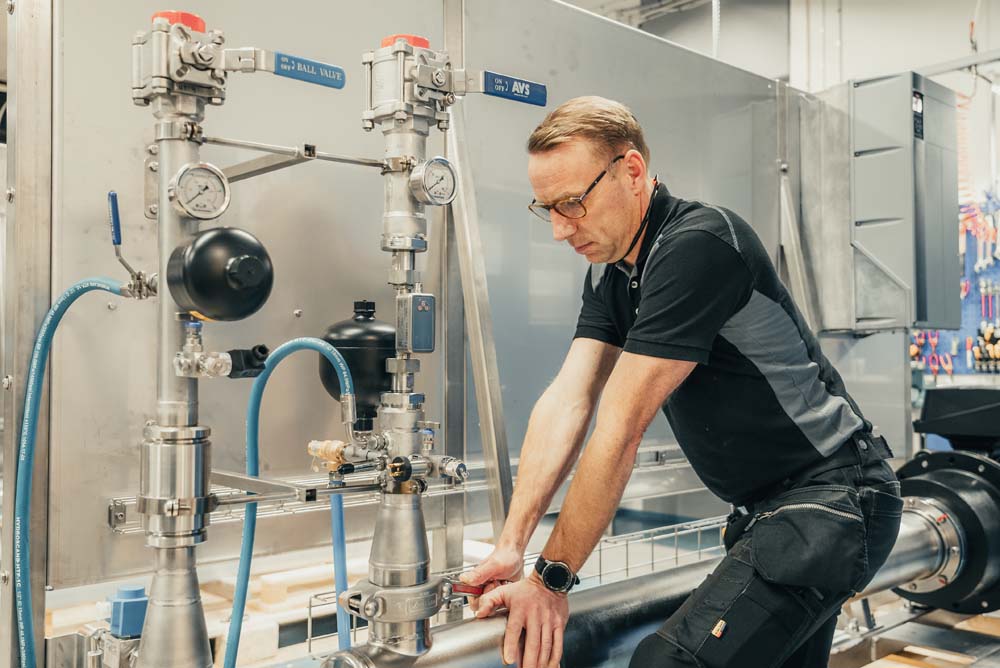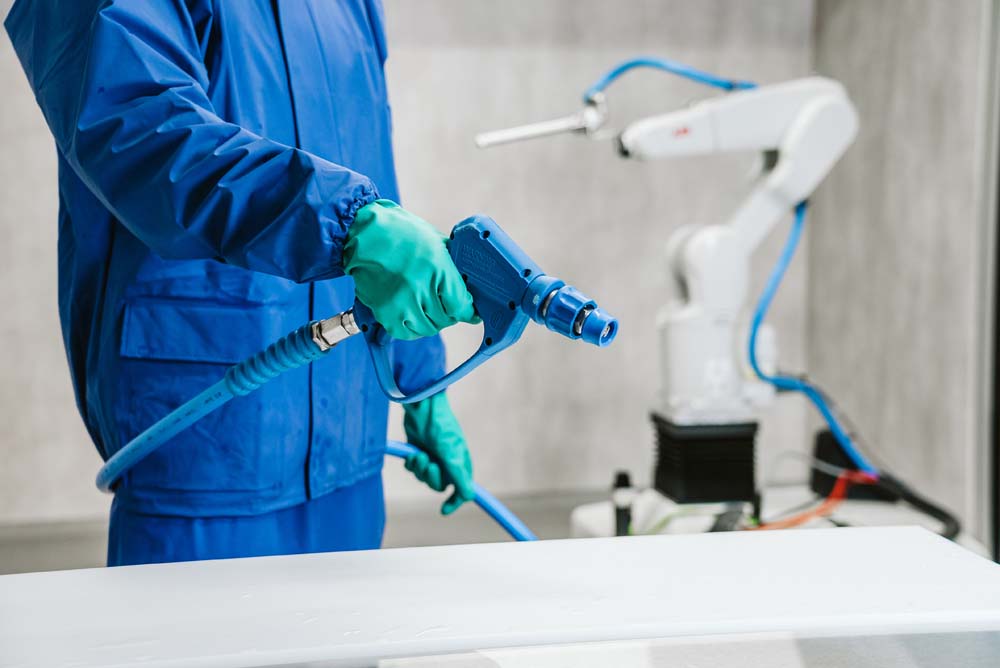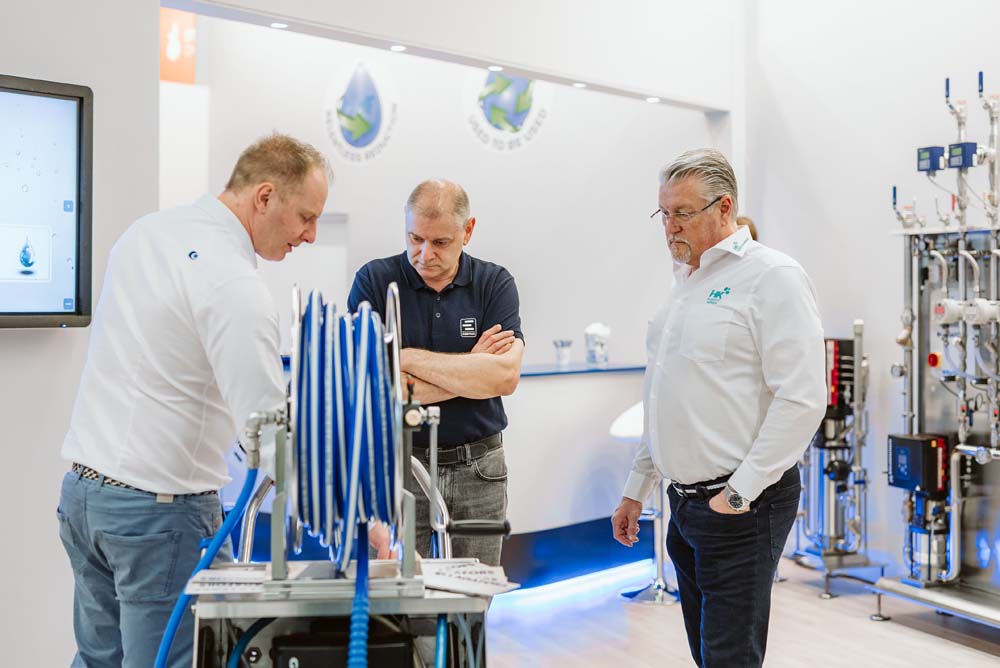This Is How the Cleaning Process Works
With a cleaning system from Lagafors®, you achieve the following: reduced chemical and water consumption, less time spent on cleaning, and a lower environmental impact. At the same time, you get a safer and more reliable result. Here, we explain and demonstrate how the process works.
1. Preparing Floor Surfaces
According to food safety regulations, any area to be cleaned with chemicals must be cleared of unpackaged food products. Remove any items such as racks, crates, carts, and pallets that are not to be cleaned on-site. The cleaning process will be significantly easier if carried out in as open a space as possible.
Moisture-sensitive production equipment should be covered with plastic sheeting, which is removed once cleaning is complete. Scrape together and pick up any product residue from the floor.
2. Pre-rinsing
Pre-rinse using a pre-rinse nozzle or blue nozzle. Water temperature should not exceed 40°C (104°F), as higher temperatures can cause proteins to coagulate (burn onto the surface), making further cleaning more difficult. Pre-rinsing is only intended to remove coarse contaminants and loosen the surface for cleaning.
3. Floor Scraping
Any remaining product residue on the floor should be collected using a heavy-duty rubber scraper and removed. Never scrape or flush contaminants into floor drains or channels.
4. Foam Application
If the cleaning agent is applied in the form of foam, it must have a consistency and stability (adhesion) that allows it to remain on vertical surfaces for a period of time. Foam is applied using the white nozzle. Avoid applying foam to too large an area at once, as it may dry out before rinsing.
When applying foam to vertical surfaces, always apply from the bottom up. Cleaning agent dosage must follow specified guidelines. Keep in mind that overdosing does not enhance cleaning effectiveness and may even result in negative effects.
5. Contact Time
During the contact time, dirt is encapsulated and saponified (turned into soap).
6. Main Rinsing
When rinsing vertical surfaces, start from the top and work downwards. If using increased pressure, the distance between the nozzle and the surface should be approximately 30 cm (about 12 inches). The water jet should strike the surface at an angle between 45° and 90°.
Rinsing is done with a blue nozzle (long or short). Water temperature should match the chemical composition of the contamination and the cleaning agent used. Normal temperature is 50°C – 60°C (122°F – 140°F). All rinsing should be completed within 1 hour of foam application to prevent drying and residue build-up.
7. Disinfection
Disinfection should be carried out using the yellow nozzle if applied as a clear liquid, or the white nozzle if applied as foam. It is especially important to always follow the prescribed dosage during disinfection. Typically, only surfaces that come into contact with open products are disinfected.
8. Final Rinse
Regulations require that all disinfectant be rinsed off before production may resume. Rinse using the pre-rinse or blue nozzle.
Please Note:
– The cleaning equipment itself must also be cleaned, using the same method as for other equipment.
– Maintenance of the cleaning equipment should follow Lagafors’ recommendations.
– Cleaned production equipment must not be wiped with ordinary cloths or rubber scrapers.
Clean with Optimized Parameters

Chemistry
Alkaline detergents – with a high pH value, they are effective against fat and protein residues.
Acidic detergents – have a low pH value and are effective against deposits such as limescale, oxides, and rust.
Disinfectants – can be either alkaline or acidic and have a killing effect on remaining microorganisms after cleaning.
Combined cleaning and disinfecting agents – these have a certain killing effect on microorganisms, but not as effective as a separate disinfectant.
Temperature
When pre-rinsing, the water temperature should normally be about 40 °C and at rinsing about 55 °C. This is achieved through a special pre-rinse nozzle that lowers the temperature during pre-rinse.
Too high temperatures can lead to burning and cause unnecessary costs.
Too low temperatures lead to longer cleaning times and inability to digest fat.


Energy
To compensate for the mechanical action of a brush, water pressure can be increased according to the following table:
- under 5 bar – 50-80 liters/min
- 20 bar – 30 liters/min
- 40 bar – 22 liters/min
- 80 bar – 18 liters/min
Variable-speed pumps also contribute to energy savings.
Time
Time is the largest cost factor in external cleaning—accounting for around 50% of the total cost.
If you want to reduce time-related costs, increasing water volume, chemical dosage, or temperature won’t help—you’ll simply shift the cost to other areas.
To reduce labor hours, automating the cleaning process is highly effective.
Another way to cut down on labor hours is to install dishwashers for items such as cutting boards, carts, and crates.
